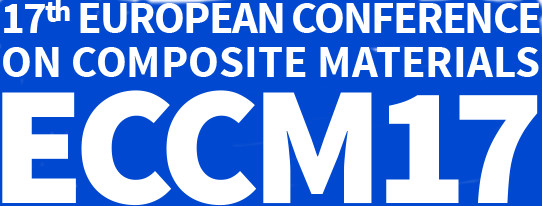

App-Einstellungen:
Information
Here you can download the papers of the ECCM17 separately. They are sorted by their presentation ID.
BRIDGING SCALES IN FLUID-SOLID-POROUS MODELLING APPROACHES OF INFUSION-BASED PROCESSES IN INDUSTRIAL CONTEXT
Sylvain Drapier (Mines Saint-Etienne) Maxime Blais (Hexcel Reinforcements) Pierre-Jacques Liotier (Mines Saint-Etienne) Nicolas Moulin (Mines Saint-Etienne) J. Bruchon (Mines Saint-Etienne)
Modelling infusion-based processes is a challenge that is partly raised through the fluid-solid-porous approach developed at Mines Saint-Etienne. In collaboration with Hexcel, research intend to bridge approaches at macro (existing) and micro scales.
CONSTITUTIVE MODELING OF CARBON FIBER FABRIC: FROM MATERIAL PARAMETER IDENTIFICATION TO APPLICATION IN FE FORMING SIMULATION
Masato Nishi (JSOL Corporation) Ichiro Taketa (Toray) Akira Iwata (Toray) Tei Hirashima (JSOL Corporation)
The influence of transverse shear deformation upon bending behavior, especially small wrinkling, was numerically examined in this paper. It has become clear that the small wrinkling is predominantly caused by transverse shear deformation.
FORMING SIMULATION OF COMPOSITES WITH THERMO-VISCOUS PROPERTIES
Martin Schulz (Dassault Systemes Deutschland GmbH) Jens Lüke (Dassault Systemes Deutschland GmbH)
For the simulation of an thermoforming process of fiber reinforced thermoplastics a user defined material constitutive la as well as a user defined "sticky" contact with anisotropic friction was developed for Abaqus. The status quo will be presented.
INVERSE CHARACTERIZATION METHOD FOR DRAPING SIMULATION BASED ON AUTOMATIC MEASUREMENT OF FIBER ORIENTATION
Arnaud Dereims (ESI Group) Pierre Marquette (ESI Group) Pierre Guyon (ESI Group) Julien Colmars (University of Lyon) Anh Tuan Ta (INSA de Lyon) Philippe Boisse (INSA de Lyon)
This paper presents an innovative methods allowing for inverse characterization of shearing sitiffness which is a key input for draping or forming simulation of fabrics. This work was carried out within FibreMap project (FP7 European project).
INVESTIGATION AND SIMULATION OF FORMING BEHAVIOUR OF PREFORMS MADE BY DIRECT FIBRE PLACEMENT
Manuel Tartler (Compositence GmbH) Dominik Hägele (Compositence GmbH) Julian Fial (University of Stuttgart) Mathias Engelfried (University of Stuttgart) Ingo Karb (Compositence GmbH) Peter Middendorf (University of Stuttgart)
FE-Simulations are needed to predict the forming capability and behaviour of preforms made by direct fibre placement. Material properties are measured by different test methods and the simulation results are compared to experimental forming tests.
MESO-MACRO MODELLING THE IN-PLANE SHEAR DEFORMATION BEHAVIOUR OF NCF CARBON/EPOXY PREPREGS IN AUTOMOTIVE APPLICATIONSEAR DEFORMATION BEHAVIOUR OF NCF CARBON/EPOXY PREPREGS IN AUTOMOTIVE APPLICATIONS
M. A. Khan (Coventry University) Phil Swanson (Coventry University)
The present work is aimed at simulating the deformation behaviour of NCF prepregs with meso/macro-scale modelling approaches in Abaqus/Explicit using the hypoelatic computational model. The simulation results are compared with experiments.
NUMERICAL METHODS FOR 3D COMPRESSIVE RTM SIMULATIONS
Pierre Marquette (ESI Group) Arnaud Dereims (ESI Group) Takayuki Ogawa (ESI Group) Masatoshi Kobayashi (HONDA R&D)
This paper presents advanced numerical methods for 3D compressive compressive RTM simulations developped by ESI Group in partnership with HONDA R&D.
NUMERICAL MODELLING OF FLOW AND HEAT TRANSFER FOR THE COMPRESSION RTM PROCESS WITH A FAST-CURE EPOXY
Andre Keller (University of Applied Sciences and Arts Northwestern Switzerland) Clemens Dransfeld (University of Applied Sciences and Arts Northwestern Switzerland) Kunal Masania (ETH Zürich)
The aim of this study is to investigate the exothermic reaction, the resulting temperature gradient and degree of cure variation over the thickness of a composite plate during impregnation and cure with a fast-cure epoxy.
SENSITIVITY OF MATERIAL PROPERTIES ON THE WRINKLING BEHAVIOR OF UD-TAPE LAMINATES ANALYZED BY FINITE ELEMENT FORMING SIMULATION
Dominik Doerr (Karlsruhe Institute of Technology) Tobias Joppich (Fraunhofer ICT) Fabian Schirmaier (Karlsruhe Institute of Technology) Tobias Mosthaf (Karlsruhe Institute of Technology) Luise Kärger (Karlsruhe Institute of Technology) Frank Henning (Karlsruhe Institute of Technology)
Methods for Finite Element forming simulation are presented, validated and subsequently applied to a virtual sensitivity study, to investigate the influence of material properties on wrinkling behavior and fiber reorientation.
